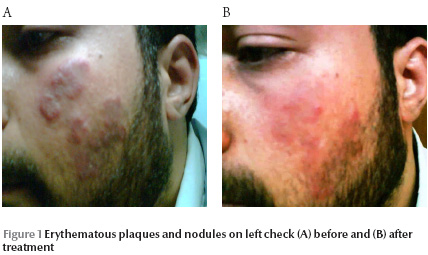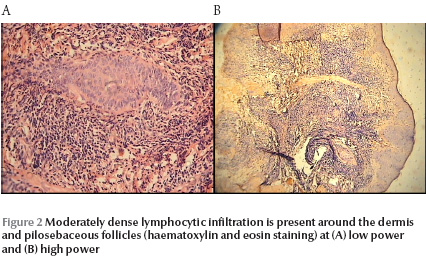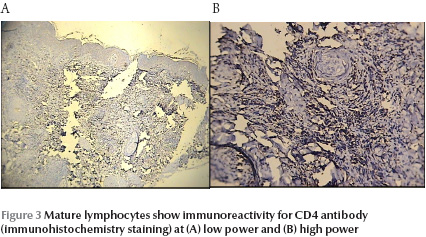Case report
EMHJ, 2012, 18(5): 537-538
G. Sadeghian 1 and H. Ziaei 2
Introduction
Jessner lymphocytic infiltration of the skin is an uncommon skin disorder characterized by benign accumulations of lymphocytes by a “coat-sleeve”-like perivascular infiltration in the skin [1]. These small lesions are solid, pink or red in colour and appear on the face, neck and back. The lesions may remain unchanged for several years and then spontaneously disappear, leaving no scars [2]. Prognosis is good because lymphocytic infiltration of the skin may resolve spontaneously and require no treatment. Treatments include cosmetic camouflage, photo-protection, excision of small lesions, topical steroids, hydroxychloroquine, intralesional steroids, systemic steroids and cryotherapy [3].
We report here on a case of Jessner lymphocytic infiltration associated with an atrophic scar due to cutaneous leishmaniasis from 5 years before.
Case report
A 30-year-old man presented with asymptomatic erythematous nodules and plaques on the face where he had suffered cutaneous leishmaniasis (CL) 5 years before, which had improved leaving an atrophic scar (Figure 1A). The lesion had begun as 1 nodule but had gradually progressed to several nodules and plaques. The disease had lasted for 1 year and there was history of indolent courses of resolution and subsequent recurrence. Skin examination revealed multiple erythematic deeply infiltrated nodules and plaques with smooth and shiny surface with no evidence of scaling.

At first, in view of the patient’s history, the lupoid form of CL was suggested, and the patient was treated with systemic antileishmanial therapy (meglumine antimoniate, 20 mg/kg for 20 days). There was no sign of improvement and the lesions continued to progress.
In paraclinical examination all routine biochemical and haematological investigations, including urine analysis, complete blood count, erythrocyte sedimentation rate, antinuclear antibody test, anti-Ro and anti-La antibodies were normal. Direct smear for leishman bodies was negative. A biopsy sent for routine haematoxylin and eosin staining revealed a normal epidermis with well-demarcated dense perivascular infiltrate and periadnexal infiltrate in the dermis composed of mature lymphocytes (Figure 2) and these lymphocytes showed immunoreactivity to CD4 antibodies with immunohistochemistry (IHC) staining (Figure 3). There was no sign of granuloma formation or histiocytes containing Leishman bodies or other signs of leishmaniasis.


The diagnosis was changed to lymphocytic infiltration of the skin and the patient was treated with triamcinolone ointment twice daily. The lesions disappeared after 2 weeks (Figure 1B). The patient was followed up and fortunately there was no recurrence of the problem after 3 years of follow-up
Discussion
Jessner and Kanof first described as an uncommon skin condition in 1953 [4]. The condition, now known as Jessner lymphocytic infiltration of the skin, is poorly understood and indeed the very existence of such a condition has been questioned. The literature suggests however that certain patients monitored for as long as 30 years remain within the spectrum of Jessner lymphocytic infiltration with no progression [3].
The cause of Jessner lymphocytic infiltration is unknown. Over the years a number of etiologies have been proposed. Several studies have linked Borrelia spp. infection to lymphocytic infiltration of the skin, yet most recent studies have disputed this association [3,5]. There has been a report in the past of drug eruptions induced by angiotensin-converting enzyme inhibitors that resemble lymphocytic infiltrate (of Jessner–Kanof) [6]. This condition was also reported after treatment with a hydroquinone containing bleaching cream [7]. Histologically, moderately dense superficial and deep perivascular lymphocytic infiltrate is observed in the dermis. In our case there was also infiltration in the dermis, the epidermis was normal and there was no evidence of discoid lupus erythematosus including atrophy, follicular plaguing or basal layer vacuolation. There was no sign of dermal oedema seen in polymorphous light eruption and no germinal follicle formation as would be observed in lymphocytoma cutis or cutaneous follicular centre cell lymphoma. On the other hand, there was no evidence in this case of leishman bodies or granulomatous reactions, as seen in lupoid leishmaniasis.
There are no other reports of Jessner lymphocytic infiltration following CL and this is the first time that this condition was reported as presenting on the scar of parasitic diseases from CL. Due to the similarity to the lupoid type of CL the lesions were misdiagnosed at first, but biopsy and immunoreactivity to CD4 antibodies (IHC staining) confirmed the diagnosis.
References
- Dippel E et al. Familial lymphocytic infiltration of the skin: histochemical and molecular analysis in three brothers. Dermatology (Basel, Switzerland), 2002, 204:12–16.
- Lymphocytic infiltrate of Jessner. WebMD [online factsheet] (http://www.webmd.com/skin-problems-and-treatments/lymphocytic-infiltrate-of-jessner. accessed 22 May 2011).
- Jessner lymphocytic infiltration of the skin. Medscape reference [online factsheet] (http://emedicine.com/derm/topic200.htm, accessed 22 May 2011).
- Jessner M, Kanof NB. Lymphocytic infiltration of the skin. Archives of Dermatology, 1953, 68:447–449.
- Abele DC, Anders KH, Chandler FW. Benign lymphocytic infiltration (Jessner–Kanof): another manifestation of borreliosis. Journal of the American Academy of Dermatology, 1989, 21:795–797.
- Schepis C et al. ACE-inhibitor-induced drug eruption resembling lymphocytic infiltration (of Jessner–Kanof) and lupus erythematosus tumidus. Dermatology (Basel, Switzerland), 2004, 208:354–355.
- Caroli UM et al. Lymphocytic infiltration of the skin Jessner–Kanof after treatment with a hydroquinone-containing bleaching cream. Archives of Dermatology, 2006, 142:1655–1656.




 Volume 31, number 5 May 2025
Volume 31, number 5 May 2025 WHO Bulletin
WHO Bulletin Pan American Journal of Public Health
Pan American Journal of Public Health The WHO South-East Asia Journal of Public Health (WHO SEAJPH)
The WHO South-East Asia Journal of Public Health (WHO SEAJPH)